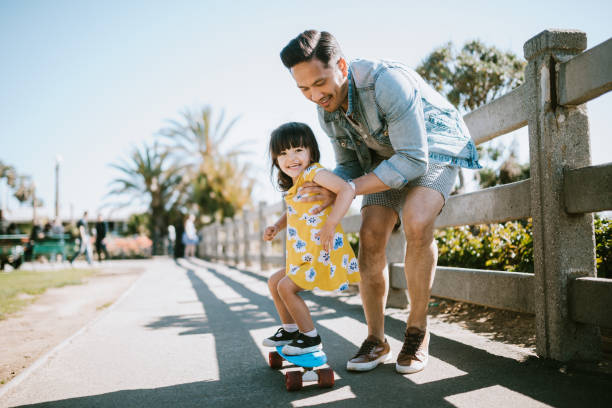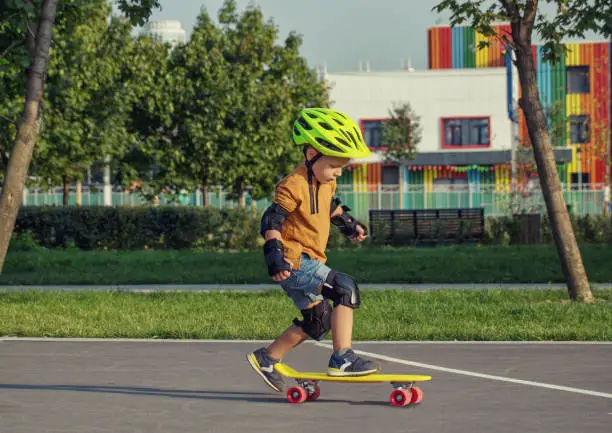How to teach skateboarding to a child with no experience. Are you a parent looking to teach your child how to skateboard? It can be a daunting task, especially if you have no experience yourself. But don’t worry, with the right guidance and approach, you can make it a fun and rewarding experience for both you and your child.
In this article, I will share with you my tips and tricks on howhttps://fineinnovations.com/teaching-skateboard-tricks-to-kids/ to teach skateboarding to a child with no experience. From choosing the right equipment to basic techniques and safety measures, I’ll cover everything you need to know to get your child rolling on a skateboard in no time. So let’s dive in and get started!
Choosing the right skateboard
Before starting to teach your child how to skateboard, it’s important to choose the right skateboard. The size of the skateboard should be appropriate for your child’s height and shoe size.
A good way to measure the right size is to have your child stand on the board with their feet shoulder-width apart. The skateboard should reach from the ground up to the midsection.
Additionally, look for a skateboard with a deck made of sturdy materials like maple wood, and with wheels that are not too hard or too soft.
You want your child to feel comfortable and safe while riding, and a suitable skateboard can make all the difference.
Getting comfortable with the balance
When teaching a child to skateboard, one of the most important skills to develop is balance. Getting comfortable on a skateboard requires practice, patience, and a willingness to push yourself outside of your comfort zone.
Start by standing on the skateboard with your feet shoulder-width apart and focusing on keeping your weight centered over the board.
As you get more comfortable, try shifting your weight back and forth and practicing turning the board. Remember, the key is to take it slow and not get discouraged if you don’t get it right away.
With time and practice, you’ll soon find your balance and be ready to take on more challenging skills.

Starting with basic movements
When it comes to teaching skateboarding to a child with no experience, starting with basic movements is essential.
Before moving on to any tricks or maneuvers, the child should first get comfortable with simply standing on the board and pushing off to gain momentum.
From there, they can work on turning, stopping, and other fundamental movements. It’s important not to rush this stage and to allow the child to progress at their own pace.
By mastering the basics, they will build a solid foundation for future skateboarding skills.

Practicing turning
Turning is a fundamental skill in skateboarding and it’s important to practice it until it becomes second nature. Start by practicing on flat surfaces to get comfortable with the motion.
Once you’ve got the hang of it, you can move on to practicing turns while rolling.
Don’t be afraid to start with small turns and work your way up to bigger ones. Remember to shift your weight in the direction you want to turn and use your toes and heels to guide the board.
With practice, you’ll be able to turn smoothly and confidently, making it easier to maneuver around obstacles and perform more advanced tricks.
Developing confidence on the board
Developing confidence on a skateboard takes time and practice, but it’s essential for your child to feel comfortable on their board.
As a parent, you can help by encouraging them to keep trying and reminding them that falling is a natural part of the learning process.
Start by practicing basic movements and turning, and gradually work your way up to more complex tricks.
As your child becomes more comfortable on the board, they’ll start to develop their own style and feel more confident in their abilities.
Remember to always prioritize safety, and never push your child to try something they’re not ready for. With patience and perseverance, your child will soon be shredding the pavement with ease!
Learning to stop safely
Learning to stop safely is a crucial skill that every beginner skateboarder needs to master. When you are comfortable with balancing and basic movements, it’s time to learn how to stop the board without falling.
One of the most effective ways to stop is by using your back foot to drag on the ground, creating friction and slowing the board down.
Another technique is heel drag, where you angle your back foot and drag the heel along the ground. Remember to start practicing in a safe and flat area, and always wear protective gear to prevent injuries.
With patience and practice, you’ll soon be able to stop safely and confidently, making skateboarding a fun and safe activity for you and your child.
Introducing basic tricks
Now that you’ve become more comfortable on the board and have mastered the basics, it’s time to introduce some basic tricks. These are the building blocks that will lead to more advanced moves down the road.
Start with simple tricks like the ollie or the kickflip. It may take some time and patience to get the hang of them, but with practice, you’ll start to see progress. Remember to always wear protective gear and practice in a safe environment.
With the right mindset and some determination, you’ll be surprised at what you can accomplish. So let’s get out there and start having some fun!
Finding the right skate park
When it comes to finding the right skate park for your child, it’s important to do some research ahead of time. You want to look for a park that is beginner-friendly and has plenty of space to practice.
Consider factors such as the park’s layout, the surfaces of the skating area, and whether it has features that your child is comfortable with. It’s also important to make sure that the park is safe and well-maintained.
Look for a park with good lighting, smooth surfaces, and safety features such as helmets and pads.
Taking the time to find the right skate park will ensure that your child has a positive experience and feels confident as they continue to learn and grow as a skater.

Encouraging progress and fun
As your child progresses in skateboarding, it’s essential to encourage their development and make it fun. Celebrate their achievements, no matter how small they may seem, and encourage them to keep trying new things.
Remember that skateboarding is all about having fun and enjoying the ride, so keep the atmosphere positive and light.
You can also try new things together, like taking on new challenges and exploring different skate parks. This way, you and your child can enjoy the journey of learning and growing in skateboarding together.
Conclusion
Congratulations! By following these steps, you can help your child learn how to skateboard safely and with confidence.
Remember to always choose the right skateboard for their size and ability, practice balance and basic movements, and introduce tricks gradually.
Encourage progress and have fun along the way! Whether they want to skate at a local park or in their own driveway, with a little bit of guidance, your child can become a skilled skateboarder in no time.
Frequently Asked Questions(FAQ)
How do you teach a little kid to skateboard?
To teach a little kid to skateboard:
-
Start with Balance: Begin by helping them find their balance on the skateboard while stationary.
-
Pushing: Teach them how to push off gently with one foot to move forward.
-
Turning: Introduce basic turning by leaning in the direction they want to go.
-
Safety Gear: Ensure they wear safety gear, including a helmet, knee pads, elbow pads, and wrist guards.
-
Supervision: Provide close supervision and support, especially during their initial attempts.
-
Practice: Encourage consistent practice in a safe, flat area.
-
Progress Gradually: As they gain confidence, introduce more advanced skills and tricks gradually.
-
Fun Approach: Make it a fun and enjoyable experience to keep them engaged and motivated.
-
Safety Reminders: Emphasize the importance of safety rules and etiquette at skateparks if they advance to that level.
-
Patience: Be patient and understanding, as learning to skateboard takes time and practice.
Always prioritize safety and ensure they are comfortable and confident before progressing to more complex maneuvers.
How should a beginner learn to skateboard?
A beginner should learn to skateboard by starting with the basics: practicing balance, pushing, turning, and stopping in a safe, flat area. Wearing protective gear, taking lessons or watching tutorials, and gradually progressing to more advanced skills are key steps in the learning process.
What skills should I learn first skateboarding?
When learning to skateboard, you should first focus on these fundamental skills:
-
Balance: Develop the ability to balance on the skateboard while stationary.
-
Pushing: Learn how to push off the ground with one foot to gain momentum and move forward.
-
Turning: Practice basic turning techniques by shifting your weight and leaning to steer.
-
Stopping: Master methods of safely slowing down and coming to a stop, like foot braking or carving.
These skills form the foundation for more advanced maneuvers and tricks in skateboarding.
Can I learn skateboarding on my own?
Yes, you can learn skateboarding on your own, but it’s often more effective and safer to start with guidance from experienced skateboarders or through instructional resources. Learning on your own may take longer and carry a higher risk of injury if safety precautions aren’t followed
How can I practice skateboarding at home?
-
Balancing: Practice balancing on your skateboard while stationary on a flat surface.
-
Ollie Practice: Work on ollie technique by practicing the motion without moving.
-
Indoor Mini-Ramps: If you have the space and necessary safety precautions, build or use a mini-ramp indoors.
-
Skateboard Tricks: Practice skateboard tricks on a carpeted or padded area to minimize impact.
-
Watch Tutorials: Watch online tutorials and instructional videos to learn new techniques and tricks.
Always prioritize safety, wear protective gear, and ensure that your practice area is free from hazards.

